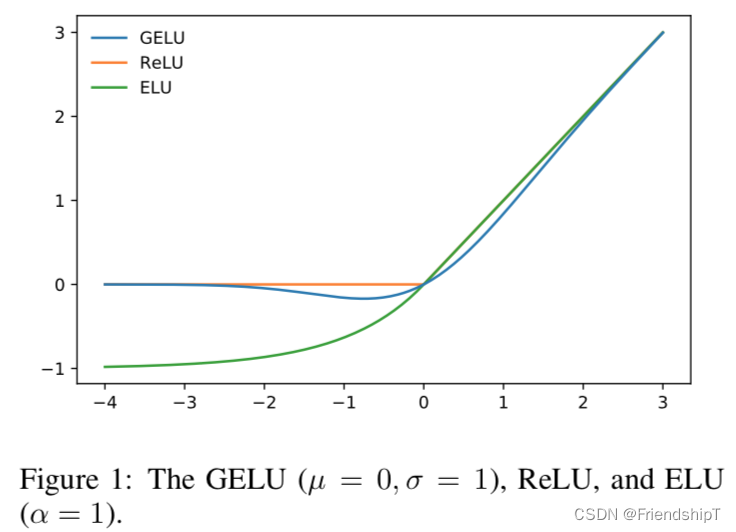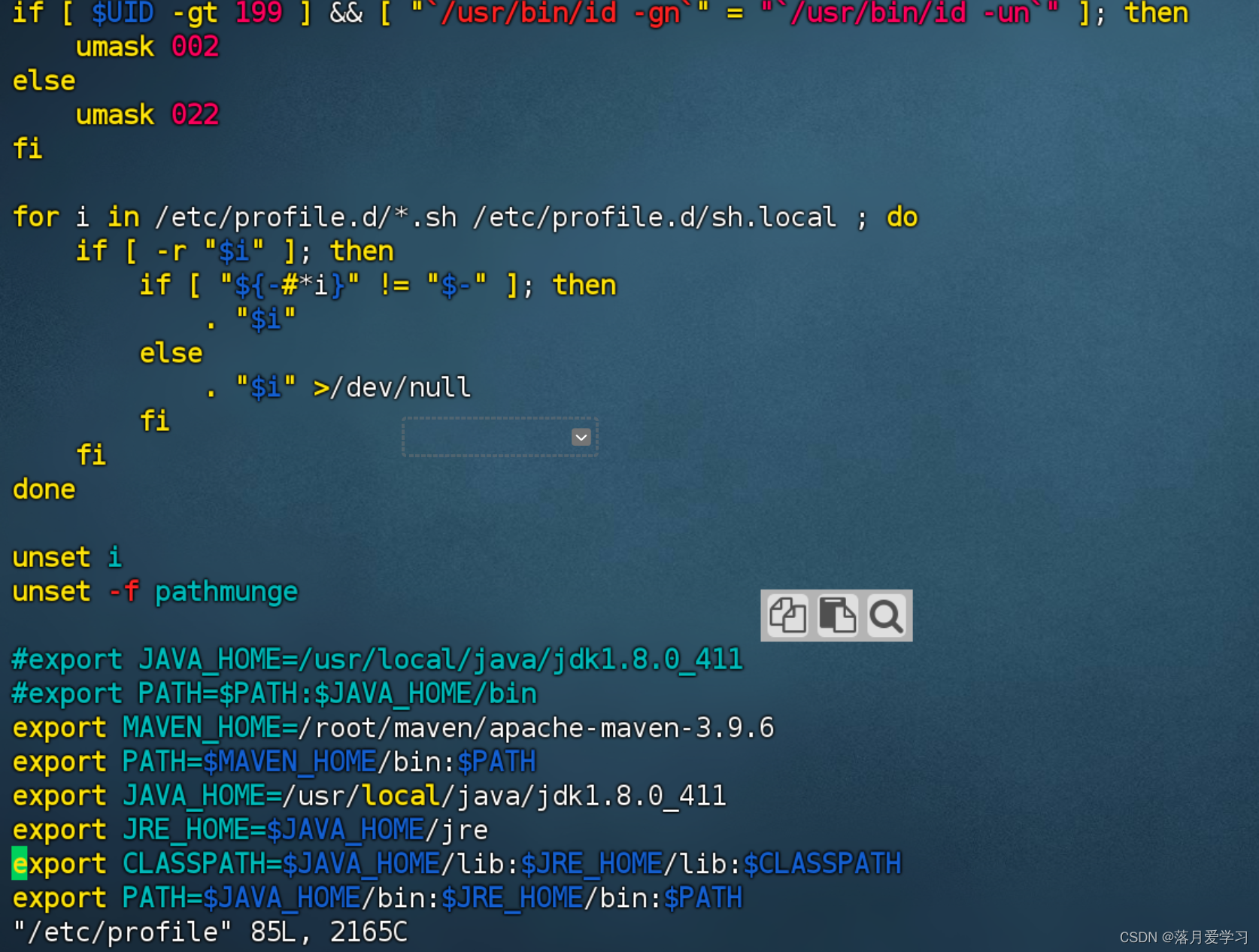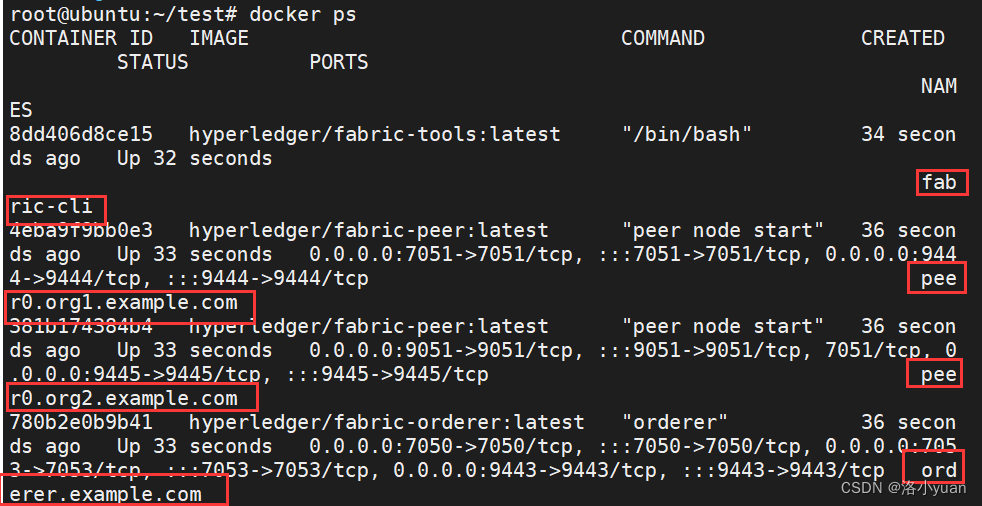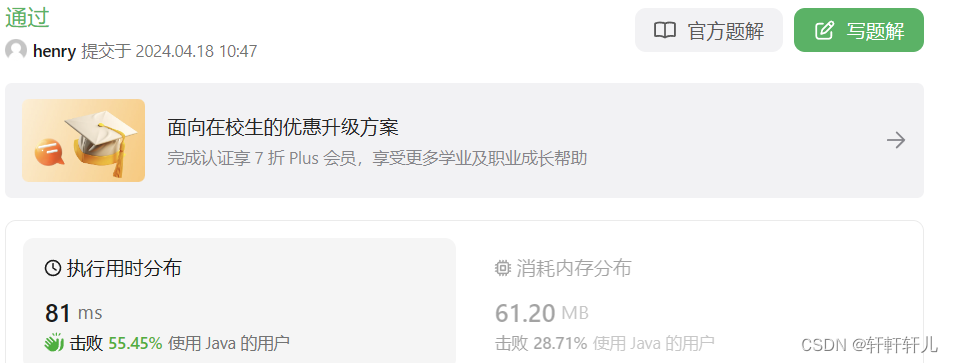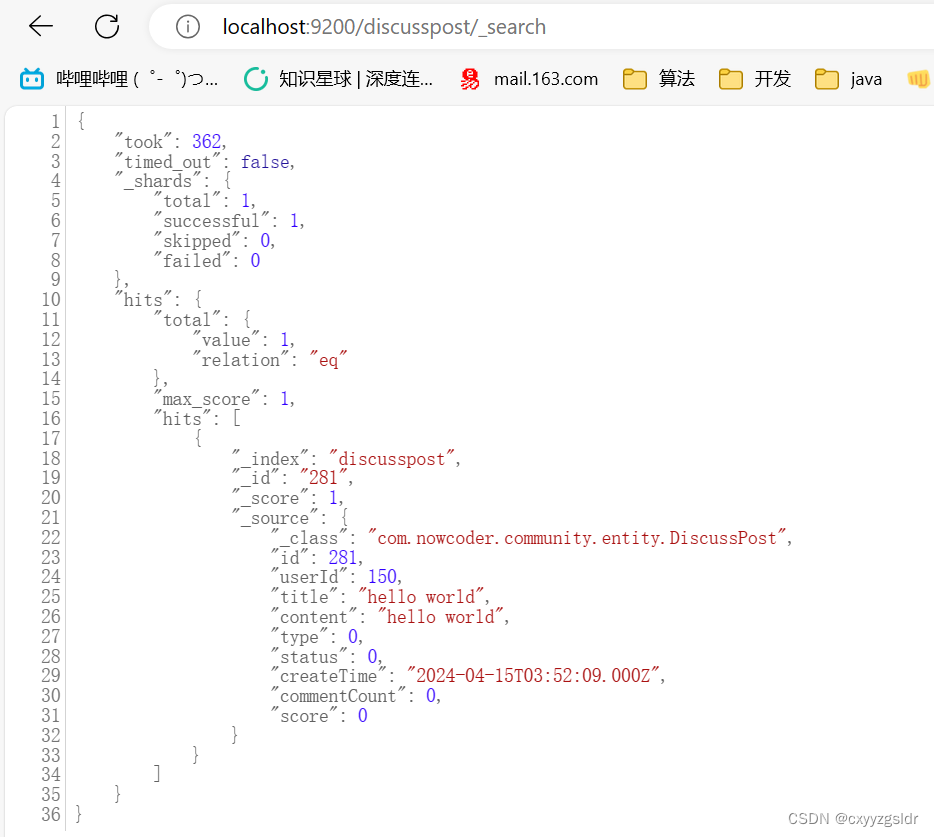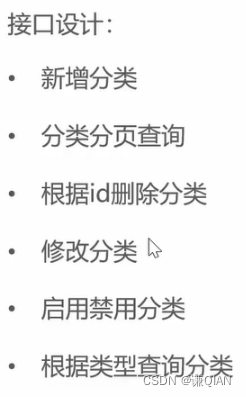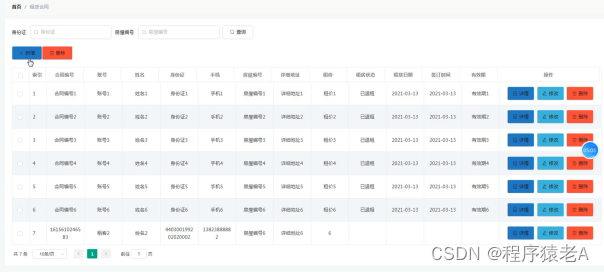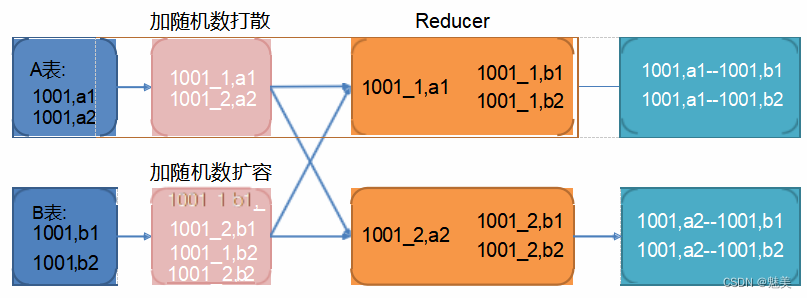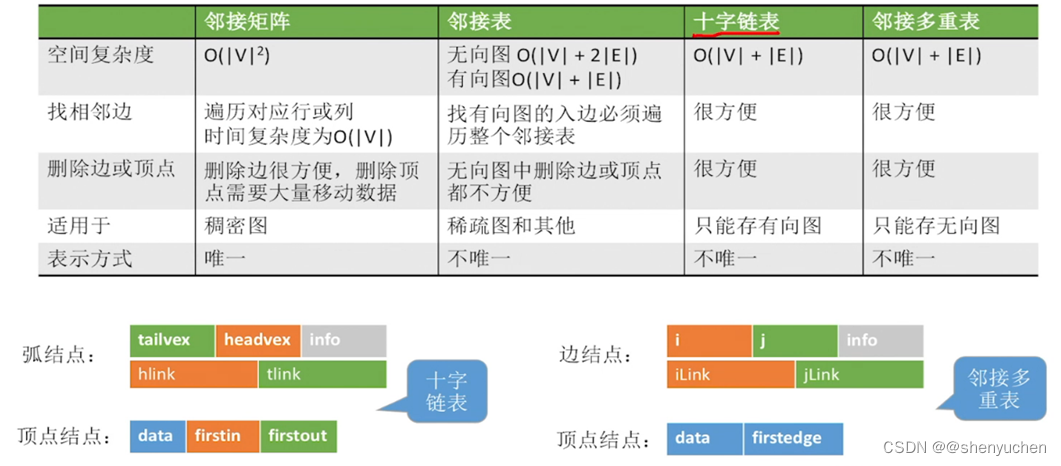前言
基于上一篇经典网络架构学习-Transformer的学习,今天我们来使用pytorch 搭建自己的transformer模型,加深对transformer的理解,不仅在NLP领域绕不开transformer,而且在CV领域也是很火热,很多模型都用到了注意力机制。
Transformer完整代码
安装好pytorch开发环境,可以直接跑的。也可以直接用cpu跑我下面的transformer代码,数据集比较小,在2G内存就够了。
# ======================================
# === Pytorch手写Transformer完整代码
# ======================================
"""
code by Tae Hwan Jung(Jeff Jung) @graykode, Derek Miller @dmmiller612, modify by shwei
Reference: https://github.com/jadore801120/attention-is-all-you-need-pytorch
https://github.com/JayParks/transformer
"""
# ====================================================================================================
# 数据构建
import math
import torch
import numpy as np
import torch.nn as nn
import torch.optim as optim
import torch.utils.data as Data
#device = 'cpu'
device = 'cuda'
# transformer epochs
epochs = 100
# epochs = 1000
# 这里我没有用什么大型的数据集,而是手动输入了两对中文→英语的句子
# 还有每个字的索引也是我手动硬编码上去的,主要是为了降低代码阅读难度
# S: Symbol that shows starting of decoding input
# E: Symbol that shows starting of decoding output
# P: Symbol that will fill in blank sequence if current batch data size is short than time steps
# 训练集
sentences = [
# 中文和英语的单词个数不要求相同
# enc_input dec_input dec_output
['我 有 一 个 好 朋 友 P', 'S I have a good friend .', 'I have a good friend . E'],
['我 有 零 个 女 朋 友 P', 'S I have zero girl friend .', 'I have zero girl friend . E'],
['我 有 一 个 男 朋 友 P', 'S I have a boy friend .', 'I have a boy friend . E']
]
# 测试集(希望transformer能达到的效果)
# 输入:"我 有 一 个 女 朋 友"
# 输出:"i have a girlfriend"
# 中文和英语的单词要分开建立词库
# Padding Should be Zero
src_vocab = {'P': 0, '我': 1, '有': 2, '一': 3,
'个': 4, '好': 5, '朋': 6, '友': 7, '零': 8, '女': 9, '男': 10}
src_idx2word = {i: w for i, w in enumerate(src_vocab)}
src_vocab_size = len(src_vocab)
tgt_vocab = {'P': 0, 'I': 1, 'have': 2, 'a': 3, 'good': 4,
'friend': 5, 'zero': 6, 'girl': 7, 'boy': 8, 'S': 9, 'E': 10, '.': 11}
idx2word = {i: w for i, w in enumerate(tgt_vocab)}
tgt_vocab_size = len(tgt_vocab)
src_len = 8 # (源句子的长度)enc_input max sequence length
tgt_len = 7 # dec_input(=dec_output) max sequence length
# Transformer Parameters
d_model = 512 # Embedding Size(token embedding和position编码的维度)
# FeedForward dimension (两次线性层中的隐藏层 512->2048->512,线性层是用来做特征提取的),当然最后会再接一个projection层
d_ff = 2048
d_k = d_v = 64 # dimension of K(=Q), V(Q和K的维度需要相同,这里为了方便让K=V)
n_layers = 6 # number of Encoder of Decoder Layer(Block的个数)
n_heads = 8 # number of heads in Multi-Head Attention(有几套头)
# ==============================================================================================
# 数据构建
def make_data(sentences):
"""把单词序列转换为数字序列"""
enc_inputs, dec_inputs, dec_outputs = [], [], []
for i in range(len(sentences)):
enc_input = [[src_vocab[n] for n in sentences[i][0].split()]]
dec_input = [[tgt_vocab[n] for n in sentences[i][1].split()]]
dec_output = [[tgt_vocab[n] for n in sentences[i][2].split()]]
#[[1, 2, 3, 4, 5, 6, 7, 0], [1, 2, 8, 4, 9, 6, 7, 0], [1, 2, 3, 4, 10, 6, 7, 0]]
enc_inputs.extend(enc_input)
#[[9, 1, 2, 3, 4, 5, 11], [9, 1, 2, 6, 7, 5, 11], [9, 1, 2, 3, 8, 5, 11]]
dec_inputs.extend(dec_input)
#[[1, 2, 3, 4, 5, 11, 10], [1, 2, 6, 7, 5, 11, 10], [1, 2, 3, 8, 5, 11, 10]]
dec_outputs.extend(dec_output)
return torch.LongTensor(enc_inputs), torch.LongTensor(dec_inputs), torch.LongTensor(dec_outputs)
enc_inputs, dec_inputs, dec_outputs = make_data(sentences)
class MyDataSet(Data.Dataset):
"""自定义DataLoader"""
def __init__(self, enc_inputs, dec_inputs, dec_outputs):
super(MyDataSet, self).__init__()
self.enc_inputs = enc_inputs
self.dec_inputs = dec_inputs
self.dec_outputs = dec_outputs
def __len__(self):
return self.enc_inputs.shape[0]
def __getitem__(self, idx):
return self.enc_inputs[idx], self.dec_inputs[idx], self.dec_outputs[idx]
loader = Data.DataLoader(
MyDataSet(enc_inputs, dec_inputs, dec_outputs), 2, True)
# ====================================================================================================
# Transformer模型
class PositionalEncoding(nn.Module):
def __init__(self, d_model, dropout=0.1, max_len=5000):
super(PositionalEncoding, self).__init__()
self.dropout = nn.Dropout(p=dropout)
pe = torch.zeros(max_len, d_model)
position = torch.arange(0, max_len, dtype=torch.float).unsqueeze(1)
div_term = torch.exp(torch.arange(
0, d_model, 2).float() * (-math.log(10000.0) / d_model))
pe[:, 0::2] = torch.sin(position * div_term)
pe[:, 1::2] = torch.cos(position * div_term)
pe = pe.unsqueeze(0).transpose(0, 1)
self.register_buffer('pe', pe)
def forward(self, x):
"""
x: [seq_len, batch_size, d_model]
"""
x = x + self.pe[:x.size(0), :]
return self.dropout(x)
def get_attn_pad_mask(seq_q, seq_k):
# pad mask的作用:在对value向量加权平均的时候,可以让pad对应的alpha_ij=0,这样注意力就不会考虑到pad向量
"""这里的q,k表示的是两个序列(跟注意力机制的q,k没有关系),例如encoder_inputs (x1,x2,..xm)和encoder_inputs (x1,x2..xm)
encoder和decoder都可能调用这个函数,所以seq_len视情况而定
seq_q: [batch_size, seq_len]
seq_k: [batch_size, seq_len]
seq_len could be src_len or it could be tgt_len
seq_len in seq_q and seq_len in seq_k maybe not equal
"""
batch_size, len_q = seq_q.size() # 这个seq_q只是用来expand维度的
batch_size, len_k = seq_k.size()
# eq(zero) is PAD token
# 例如:seq_k = [[1,2,3,4,0], [1,2,3,5,0]]
# [batch_size, 1, len_k], True is masked
pad_attn_mask = seq_k.data.eq(0).unsqueeze(1)
# [batch_size, len_q, len_k] 构成一个立方体(batch_size个这样的矩阵)
return pad_attn_mask.expand(batch_size, len_q, len_k)
def get_attn_subsequence_mask(seq):
"""建议打印出来看看是什么的输出(一目了然)
seq: [batch_size, tgt_len]
"""
attn_shape = [seq.size(0), seq.size(1), seq.size(1)]
# attn_shape: [batch_size, tgt_len, tgt_len]
subsequence_mask = np.triu(np.ones(attn_shape), k=1) # 生成一个上三角矩阵
subsequence_mask = torch.from_numpy(subsequence_mask).byte()
return subsequence_mask # [batch_size, tgt_len, tgt_len]
# ==========================================================================================
class ScaledDotProductAttention(nn.Module):
def __init__(self):
super(ScaledDotProductAttention, self).__init__()
def forward(self, Q, K, V, attn_mask):
"""
Q: [batch_size, n_heads, len_q, d_k]
K: [batch_size, n_heads, len_k, d_k]
V: [batch_size, n_heads, len_v(=len_k), d_v]
attn_mask: [batch_size, n_heads, seq_len, seq_len]
说明:在encoder-decoder的Attention层中len_q(q1,..qt)和len_k(k1,...km)可能不同
"""
scores = torch.matmul(Q, K.transpose(-1, -2)) / \
np.sqrt(d_k) # scores : [batch_size, n_heads, len_q, len_k]
# mask矩阵填充scores(用-1e9填充scores中与attn_mask中值为1位置相对应的元素)
# Fills elements of self tensor with value where mask is True.
scores.masked_fill_(attn_mask, -1e9)
attn = nn.Softmax(dim=-1)(scores) # 对最后一个维度(v)做softmax
# scores : [batch_size, n_heads, len_q, len_k] * V: [batch_size, n_heads, len_v(=len_k), d_v]
# context: [batch_size, n_heads, len_q, d_v]
context = torch.matmul(attn, V)
# context:[[z1,z2,...],[...]]向量, attn注意力稀疏矩阵(用于可视化的)
return context, attn
class MultiHeadAttention(nn.Module):
"""这个Attention类可以实现:
Encoder的Self-Attention
Decoder的Masked Self-Attention
Encoder-Decoder的Attention
输入:seq_len x d_model
输出:seq_len x d_model
"""
def __init__(self):
super(MultiHeadAttention, self).__init__()
self.W_Q = nn.Linear(d_model, d_k * n_heads,
bias=False) # q,k必须维度相同,不然无法做点积
self.W_K = nn.Linear(d_model, d_k * n_heads, bias=False)
self.W_V = nn.Linear(d_model, d_v * n_heads, bias=False)
# 这个全连接层可以保证多头attention的输出仍然是seq_len x d_model
self.fc = nn.Linear(n_heads * d_v, d_model, bias=False)
def forward(self, input_Q, input_K, input_V, attn_mask):
"""
input_Q: [batch_size, len_q, d_model]
input_K: [batch_size, len_k, d_model]
input_V: [batch_size, len_v(=len_k), d_model]
attn_mask: [batch_size, seq_len, seq_len]
"""
residual, batch_size = input_Q, input_Q.size(0)
# 下面的多头的参数矩阵是放在一起做线性变换的,然后再拆成多个头,这是工程实现的技巧
# B: batch_size, S:seq_len, D: dim
# (B, S, D) -proj-> (B, S, D_new) -split-> (B, S, Head, W) -trans-> (B, Head, S, W)
# 线性变换 拆成多头
# Q: [batch_size, n_heads, len_q, d_k]
Q = self.W_Q(input_Q).view(batch_size, -1,
n_heads, d_k).transpose(1, 2)
# K: [batch_size, n_heads, len_k, d_k] # K和V的长度一定相同,维度可以不同
K = self.W_K(input_K).view(batch_size, -1,
n_heads, d_k).transpose(1, 2)
# V: [batch_size, n_heads, len_v(=len_k), d_v]
V = self.W_V(input_V).view(batch_size, -1,
n_heads, d_v).transpose(1, 2)
# 因为是多头,所以mask矩阵要扩充成4维的
# attn_mask: [batch_size, seq_len, seq_len] -> [batch_size, n_heads, seq_len, seq_len]
attn_mask = attn_mask.unsqueeze(1).repeat(1, n_heads, 1, 1)
# context: [batch_size, n_heads, len_q, d_v], attn: [batch_size, n_heads, len_q, len_k]
context, attn = ScaledDotProductAttention()(Q, K, V, attn_mask)
# 下面将不同头的输出向量拼接在一起
# context: [batch_size, n_heads, len_q, d_v] -> [batch_size, len_q, n_heads * d_v]
context = context.transpose(1, 2).reshape(
batch_size, -1, n_heads * d_v)
# 这个全连接层可以保证多头attention的输出仍然是seq_len x d_model
output = self.fc(context) # [batch_size, len_q, d_model]
return nn.LayerNorm(d_model).to(device)(output + residual), attn
# Pytorch中的Linear只会对最后一维操作,所以正好是我们希望的每个位置用同一个全连接网络
class PoswiseFeedForwardNet(nn.Module):
def __init__(self):
super(PoswiseFeedForwardNet, self).__init__()
self.fc = nn.Sequential(
nn.Linear(d_model, d_ff, bias=False),
nn.ReLU(),
nn.Linear(d_ff, d_model, bias=False)
)
def forward(self, inputs):
"""
inputs: [batch_size, seq_len, d_model]
"""
residual = inputs
output = self.fc(inputs)
# [batch_size, seq_len, d_model]
return nn.LayerNorm(d_model).to(device)(output + residual)
class EncoderLayer(nn.Module):
def __init__(self):
super(EncoderLayer, self).__init__()
self.enc_self_attn = MultiHeadAttention()
self.pos_ffn = PoswiseFeedForwardNet()
def forward(self, enc_inputs, enc_self_attn_mask):
"""E
enc_inputs: [batch_size, src_len, d_model]
enc_self_attn_mask: [batch_size, src_len, src_len] mask矩阵(pad mask or sequence mask)
"""
# enc_outputs: [batch_size, src_len, d_model], attn: [batch_size, n_heads, src_len, src_len]
# 第一个enc_inputs * W_Q = Q
# 第二个enc_inputs * W_K = K
# 第三个enc_inputs * W_V = V
enc_outputs, attn = self.enc_self_attn(enc_inputs, enc_inputs, enc_inputs,
enc_self_attn_mask) # enc_inputs to same Q,K,V(未线性变换前)
enc_outputs = self.pos_ffn(enc_outputs)
# enc_outputs: [batch_size, src_len, d_model]
return enc_outputs, attn
class DecoderLayer(nn.Module):
def __init__(self):
super(DecoderLayer, self).__init__()
self.dec_self_attn = MultiHeadAttention()
self.dec_enc_attn = MultiHeadAttention()
self.pos_ffn = PoswiseFeedForwardNet()
def forward(self, dec_inputs, enc_outputs, dec_self_attn_mask, dec_enc_attn_mask):
"""
dec_inputs: [batch_size, tgt_len, d_model]
enc_outputs: [batch_size, src_len, d_model]
dec_self_attn_mask: [batch_size, tgt_len, tgt_len]
dec_enc_attn_mask: [batch_size, tgt_len, src_len]
"""
# dec_outputs: [batch_size, tgt_len, d_model], dec_self_attn: [batch_size, n_heads, tgt_len, tgt_len]
dec_outputs, dec_self_attn = self.dec_self_attn(dec_inputs, dec_inputs, dec_inputs,
dec_self_attn_mask) # 这里的Q,K,V全是Decoder自己的输入
# dec_outputs: [batch_size, tgt_len, d_model], dec_enc_attn: [batch_size, h_heads, tgt_len, src_len]
dec_outputs, dec_enc_attn = self.dec_enc_attn(dec_outputs, enc_outputs, enc_outputs,
dec_enc_attn_mask) # Attention层的Q(来自decoder) 和 K,V(来自encoder)
# [batch_size, tgt_len, d_model]
dec_outputs = self.pos_ffn(dec_outputs)
# dec_self_attn, dec_enc_attn这两个是为了可视化的
return dec_outputs, dec_self_attn, dec_enc_attn
class Encoder(nn.Module):
def __init__(self):
super(Encoder, self).__init__()
self.src_emb = nn.Embedding(src_vocab_size, d_model) # token Embedding
self.pos_emb = PositionalEncoding(
d_model) # Transformer中位置编码时固定的,不需要学习
self.layers = nn.ModuleList([EncoderLayer() for _ in range(n_layers)])
def forward(self, enc_inputs):
"""
enc_inputs: [batch_size, src_len]
"""
enc_outputs = self.src_emb(
enc_inputs) # [batch_size, src_len, d_model]
enc_outputs = self.pos_emb(enc_outputs.transpose(0, 1)).transpose(
0, 1) # [batch_size, src_len, d_model]
# Encoder输入序列的pad mask矩阵
enc_self_attn_mask = get_attn_pad_mask(
enc_inputs, enc_inputs) # [batch_size, src_len, src_len]
enc_self_attns = [] # 在计算中不需要用到,它主要用来保存你接下来返回的attention的值(这个主要是为了你画热力图等,用来看各个词之间的关系
for layer in self.layers: # for循环访问nn.ModuleList对象
# 上一个block的输出enc_outputs作为当前block的输入
# enc_outputs: [batch_size, src_len, d_model], enc_self_attn: [batch_size, n_heads, src_len, src_len]
enc_outputs, enc_self_attn = layer(enc_outputs,
enc_self_attn_mask) # 传入的enc_outputs其实是input,传入mask矩阵是因为你要做self attention
enc_self_attns.append(enc_self_attn) # 这个只是为了可视化
return enc_outputs, enc_self_attns
class Decoder(nn.Module):
def __init__(self):
super(Decoder, self).__init__()
self.tgt_emb = nn.Embedding(
tgt_vocab_size, d_model) # Decoder输入的embed词表
self.pos_emb = PositionalEncoding(d_model)
self.layers = nn.ModuleList([DecoderLayer()
for _ in range(n_layers)]) # Decoder的blocks
def forward(self, dec_inputs, enc_inputs, enc_outputs):
"""
dec_inputs: [batch_size, tgt_len]
enc_inputs: [batch_size, src_len]
enc_outputs: [batch_size, src_len, d_model] # 用在Encoder-Decoder Attention层
"""
dec_outputs = self.tgt_emb(
dec_inputs) # [batch_size, tgt_len, d_model]
dec_outputs = self.pos_emb(dec_outputs.transpose(0, 1)).transpose(0, 1).to(
device) # [batch_size, tgt_len, d_model]
# Decoder输入序列的pad mask矩阵(这个例子中decoder是没有加pad的,实际应用中都是有pad填充的)
dec_self_attn_pad_mask = get_attn_pad_mask(dec_inputs, dec_inputs).to(
device) # [batch_size, tgt_len, tgt_len]
# Masked Self_Attention:当前时刻是看不到未来的信息的
dec_self_attn_subsequence_mask = get_attn_subsequence_mask(dec_inputs).to(
device) # [batch_size, tgt_len, tgt_len]
# Decoder中把两种mask矩阵相加(既屏蔽了pad的信息,也屏蔽了未来时刻的信息)
dec_self_attn_mask = torch.gt((dec_self_attn_pad_mask + dec_self_attn_subsequence_mask),
0).to(device) # [batch_size, tgt_len, tgt_len]; torch.gt比较两个矩阵的元素,大于则返回1,否则返回0
# 这个mask主要用于encoder-decoder attention层
# get_attn_pad_mask主要是enc_inputs的pad mask矩阵(因为enc是处理K,V的,求Attention时是用v1,v2,..vm去加权的,要把pad对应的v_i的相关系数设为0,这样注意力就不会关注pad向量)
# dec_inputs只是提供expand的size的
dec_enc_attn_mask = get_attn_pad_mask(
dec_inputs, enc_inputs) # [batc_size, tgt_len, src_len]
dec_self_attns, dec_enc_attns = [], []
for layer in self.layers:
# dec_outputs: [batch_size, tgt_len, d_model], dec_self_attn: [batch_size, n_heads, tgt_len, tgt_len], dec_enc_attn: [batch_size, h_heads, tgt_len, src_len]
# Decoder的Block是上一个Block的输出dec_outputs(变化)和Encoder网络的输出enc_outputs(固定)
dec_outputs, dec_self_attn, dec_enc_attn = layer(dec_outputs, enc_outputs, dec_self_attn_mask,
dec_enc_attn_mask)
dec_self_attns.append(dec_self_attn)
dec_enc_attns.append(dec_enc_attn)
# dec_outputs: [batch_size, tgt_len, d_model]
return dec_outputs, dec_self_attns, dec_enc_attns
class Transformer(nn.Module):
def __init__(self):
super(Transformer, self).__init__()
self.encoder = Encoder().to(device)
self.decoder = Decoder().to(device)
self.projection = nn.Linear(
d_model, tgt_vocab_size, bias=False).to(device)
def forward(self, enc_inputs, dec_inputs):
"""Transformers的输入:两个序列
enc_inputs: [batch_size, src_len]
dec_inputs: [batch_size, tgt_len]
"""
# tensor to store decoder outputs
# outputs = torch.zeros(batch_size, tgt_len, tgt_vocab_size).to(self.device)
# enc_outputs: [batch_size, src_len, d_model], enc_self_attns: [n_layers, batch_size, n_heads, src_len, src_len]
# 经过Encoder网络后,得到的输出还是[batch_size, src_len, d_model]
enc_outputs, enc_self_attns = self.encoder(enc_inputs)
# dec_outputs: [batch_size, tgt_len, d_model], dec_self_attns: [n_layers, batch_size, n_heads, tgt_len, tgt_len], dec_enc_attn: [n_layers, batch_size, tgt_len, src_len]
dec_outputs, dec_self_attns, dec_enc_attns = self.decoder(
dec_inputs, enc_inputs, enc_outputs)
# dec_outputs: [batch_size, tgt_len, d_model] -> dec_logits: [batch_size, tgt_len, tgt_vocab_size]
dec_logits = self.projection(dec_outputs)
return dec_logits.view(-1, dec_logits.size(-1)), enc_self_attns, dec_self_attns, dec_enc_attns
model = Transformer().to(device)
# 这里的损失函数里面设置了一个参数 ignore_index=0,因为 "pad" 这个单词的索引为 0,这样设置以后,就不会计算 "pad" 的损失(因为本来 "pad" 也没有意义,不需要计算)
criterion = nn.CrossEntropyLoss(ignore_index=0)
optimizer = optim.SGD(model.parameters(), lr=1e-3,
momentum=0.99) # 用adam的话效果不好
# ====================================================================================================
for epoch in range(epochs):
for enc_inputs, dec_inputs, dec_outputs in loader:
"""
enc_inputs: [batch_size, src_len]
dec_inputs: [batch_size, tgt_len]
dec_outputs: [batch_size, tgt_len]
"""
enc_inputs, dec_inputs, dec_outputs = enc_inputs.to(
device), dec_inputs.to(device), dec_outputs.to(device)
# outputs: [batch_size * tgt_len, tgt_vocab_size]
outputs, enc_self_attns, dec_self_attns, dec_enc_attns = model(
enc_inputs, dec_inputs)
# dec_outputs.view(-1):[batch_size * tgt_len * tgt_vocab_size]
loss = criterion(outputs, dec_outputs.view(-1))
print('Epoch:', '%04d' % (epoch + 1), 'loss =', '{:.6f}'.format(loss))
optimizer.zero_grad()
loss.backward()
optimizer.step()
def greedy_decoder(model, enc_input, start_symbol):
"""贪心编码
For simplicity, a Greedy Decoder is Beam search when K=1. This is necessary for inference as we don't know the
target sequence input. Therefore we try to generate the target input word by word, then feed it into the transformer.
Starting Reference: http://nlp.seas.harvard.edu/2018/04/03/attention.html#greedy-decoding
:param model: Transformer Model
:param enc_input: The encoder input
:param start_symbol: The start symbol. In this example it is 'S' which corresponds to index 4
:return: The target input
"""
enc_outputs, enc_self_attns = model.encoder(enc_input)
# 初始化一个空的tensor: tensor([], size=(1, 0), dtype=torch.int64)
dec_input = torch.zeros(1, 0).type_as(enc_input.data)
terminal = False
next_symbol = start_symbol
while not terminal:
# 预测阶段:dec_input序列会一点点变长(每次添加一个新预测出来的单词)
dec_input = torch.cat([dec_input.to(device), torch.tensor([[next_symbol]], dtype=enc_input.dtype).to(device)],
-1)
dec_outputs, _, _ = model.decoder(dec_input, enc_input, enc_outputs)
projected = model.projection(dec_outputs)
prob = projected.squeeze(0).max(dim=-1, keepdim=False)[1]
# 增量更新(我们希望重复单词预测结果是一样的)
# 我们在预测是会选择性忽略重复的预测的词,只摘取最新预测的单词拼接到输入序列中
# 拿出当前预测的单词(数字)。我们用x'_t对应的输出z_t去预测下一个单词的概率,不用z_1,z_2..z_{t-1}
next_word = prob.data[-1]
next_symbol = next_word
if next_symbol == tgt_vocab["E"]:
terminal = True
# print(next_word)
# greedy_dec_predict = torch.cat(
# [dec_input.to(device), torch.tensor([[next_symbol]], dtype=enc_input.dtype).to(device)],
# -1)
greedy_dec_predict = dec_input[:, 1:]
return greedy_dec_predict
# ==========================================================================================
# 预测阶段
# 测试集
sentences = [
# enc_input dec_input dec_output
['我 有 零 个 女 朋 友 P', '', '']
]
enc_inputs, dec_inputs, dec_outputs = make_data(sentences)
test_loader = Data.DataLoader(
MyDataSet(enc_inputs, dec_inputs, dec_outputs), 2, True)
enc_inputs, _, _ = next(iter(test_loader))
print()
print("="*30)
print("利用训练好的Transformer模型将中文句子'我 有 零 个 女 朋 友' 翻译成英文句子: ")
for i in range(len(enc_inputs)):
greedy_dec_predict = greedy_decoder(model, enc_inputs[i].view(
1, -1).to(device), start_symbol=tgt_vocab["S"])
print(enc_inputs[i], '->', greedy_dec_predict.squeeze())
print([src_idx2word[t.item()] for t in enc_inputs[i]], '->',
[idx2word[n.item()] for n in greedy_dec_predict.squeeze()])
源代码来源于wmathor又经过了手把手教你用Pytorch代码实现Transformer模型(超详细的代码解读)
我又重新结合图整理了下代码的思路,记录并学习,并和大家分享。也为了方便日后的复习,查阅。下面,我们一步一步的慢慢解开transformer的真面目!
运行结果展示
没有使用大的数据集合,自己构建几个中文到英文的句子翻译作为数据集方便测试
- 训练集

- 测试集
# 测试集(希望transformer能达到的效果)
# 输入:"我 有 一 个 女 朋 友"
# 输出:"i have a girlfriend"
- 训练100epoch 预测结果
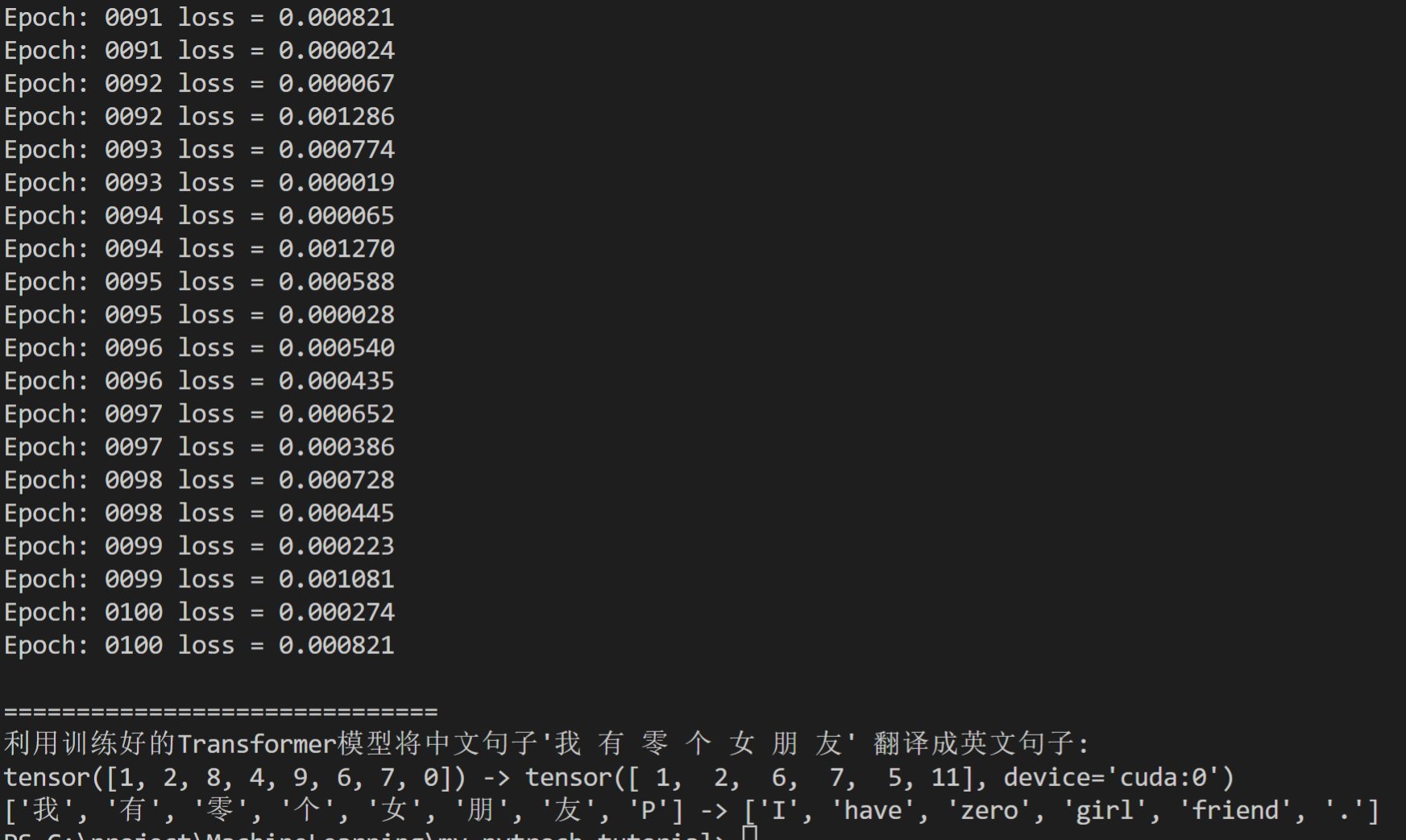
数据集处理
硬编码数据集
手动代码构造句子
entences = [
# 中文和英语的单词个数不要求相同
# enc_input dec_input dec_output
['我 有 一 个 好 朋 友 P', 'S I have a good friend .', 'I have a good friend . E'],
['我 有 零 个 女 朋 友 P', 'S I have zero girl friend .', 'I have zero girl friend . E'],
['我 有 一 个 男 朋 友 P', 'S I have a boy friend .', 'I have a boy friend . E']
]
# 测试集(希望transformer能达到的效果)
# 输入:"我 有 一 个 女 朋 友"
# 输出:"i have a girlfriend"
# 中文和英语的单词要分开建立词库
# Padding Should be Zero
src_vocab = {'P': 0, '我': 1, '有': 2, '一': 3,
'个': 4, '好': 5, '朋': 6, '友': 7, '零': 8, '女': 9, '男': 10}
src_idx2word = {i: w for i, w in enumerate(src_vocab)}
src_vocab_size = len(src_vocab)
tgt_vocab = {'P': 0, 'I': 1, 'have': 2, 'a': 3, 'good': 4,
'friend': 5, 'zero': 6, 'girl': 7, 'boy': 8, 'S': 9, 'E': 10, '.': 11}
idx2word = {i: w for i, w in enumerate(tgt_vocab)}
tgt_vocab_size = len(tgt_vocab)
src_len = 8 # (源句子的长度)enc_input max sequence length
tgt_len = 7 # dec_input(=dec_output) max sequence length
把句子转为词库中词的数字序列转换为tensor
def make_data(sentences):
"""把单词序列转换为数字序列"""
enc_inputs, dec_inputs, dec_outputs = [], [], []
for i in range(len(sentences)):
enc_input = [[src_vocab[n] for n in sentences[i][0].split()]]
dec_input = [[tgt_vocab[n] for n in sentences[i][1].split()]]
dec_output = [[tgt_vocab[n] for n in sentences[i][2].split()]]
#[[1, 2, 3, 4, 5, 6, 7, 0], [1, 2, 8, 4, 9, 6, 7, 0], [1, 2, 3, 4, 10, 6, 7, 0]]
enc_inputs.extend(enc_input)
#[[9, 1, 2, 3, 4, 5, 11], [9, 1, 2, 6, 7, 5, 11], [9, 1, 2, 3, 8, 5, 11]]
dec_inputs.extend(dec_input)
#[[1, 2, 3, 4, 5, 11, 10], [1, 2, 6, 7, 5, 11, 10], [1, 2, 3, 8, 5, 11, 10]]
dec_outputs.extend(dec_output)
return torch.LongTensor(enc_inputs), torch.LongTensor(dec_inputs), torch.LongTensor(dec_outputs)
自定义一个MyDataSet去读取这些句子
class MyDataSet(Data.Dataset):
"""自定义DataLoader"""
def __init__(self, enc_inputs, dec_inputs, dec_outputs):
super(MyDataSet, self).__init__()
self.enc_inputs = enc_inputs
self.dec_inputs = dec_inputs
self.dec_outputs = dec_outputs
def __len__(self):
return self.enc_inputs.shape[0]
def __getitem__(self, idx):
return self.enc_inputs[idx], self.dec_inputs[idx], self.dec_outputs[idx]
loader = Data.DataLoader(
MyDataSet(enc_inputs, dec_inputs, dec_outputs), 2, True)
Transformer模型代码分析
Transformer模型的参数
- d_model:我们需要定义embeding 的维度,论文中设置的512
- d_ff: FeedForward 层隐藏神经元个数
- d_k = d_v: Q、K、V 向量的维度,其中 Q 与 K 的维度必须相等,V 的维度没有限制,我们都设为 64
- n_layers:Encoder 和 Decoder 的个数,也就是图中的Nx
- n_heads:多头注意力中 head 的数量
# Transformer Parameters
d_model = 512 # Embedding Size(token embedding和position编码的维度)
# FeedForward dimension (两次线性层中的隐藏层 512->2048->512,线性层是用来做特征提取的),当然最后会再接一个projection层
d_ff = 2048
d_k = d_v = 64 # dimension of K(=Q), V(Q和K的维度需要相同,这里为了方便让K=V)
n_layers = 6 # number of Encoder of Decoder Layer(Block的个数)
n_heads = 8 # number of heads in Multi-Head Attention(有几个头)
关于代码中的注释,如果值为 src_len 或者 tgt_len 的,我一定会写清楚,但是有些函数或者类,Encoder 和 Decoder 都有可能调用,因此就不能确定究竟是 src_len 还是 tgt_len,对于不确定的,我会记作 seq_len
位置编码 Positional Encoding
Transformer 是并行输入计算的,需要知道每个字的位置信息,才能识别出语言中的顺序关系。
首先你需要知道,Transformer 是以字作为输入,将字进行字嵌入之后,再与位置嵌入进行相加(不是拼接,就是单纯的对应位置上的数值进行加和)
位置嵌入的设计应该满足以下条件:
- 每个字输出的位置编码是唯一的
- 不同长度的句子之间,任何两个字之间的差值应该保持一致
- 它的值应该是有界的
更详细的Positional Encoding介绍请看这篇博文
Positional Encoding 的计算公式如下:

公式中的sin和cos 对应着 embedding_dimension 维度的一组奇数和偶数的序号的维度。例如 0,1 一组,2,3 一组,分别用上面的sin和cos函数做处理从而产生不同的周期性变化,而位置嵌入在
embedding_dimension维度上随着维度序号增大,周期变化会越来越慢,,最终产生一种包含位置信息的纹理。周期从2Π到10000*2Π变化。
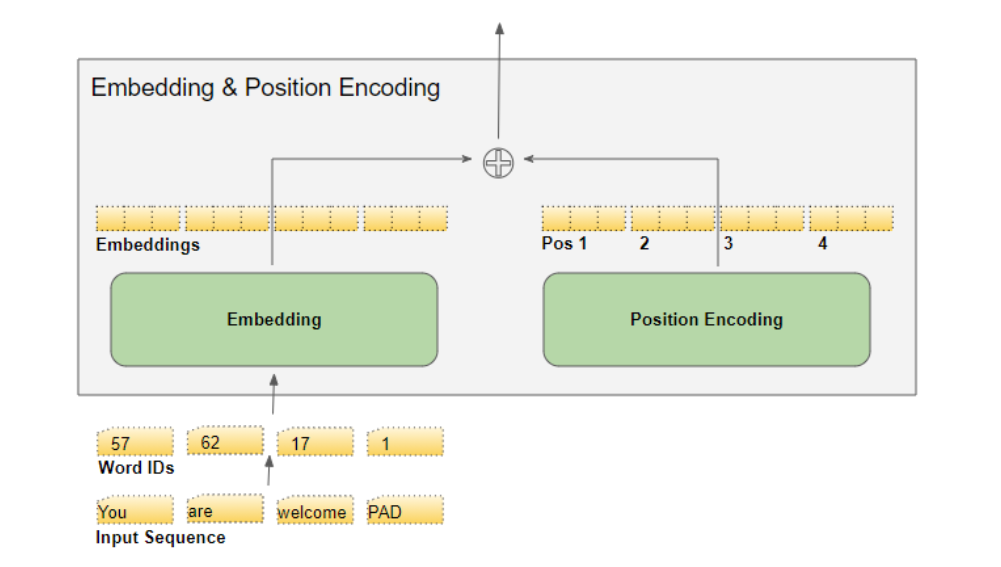
import numpy as np
import matplotlib.pyplot as plt
import seaborn as sns
import math
def get_positional_encoding(max_seq_len, embed_dim):
# 初始化一个positional encoding
# embed_dim: 字嵌入的维度
# max_seq_len: 最大的序列长度
positional_encoding = np.array([
[pos / np.power(10000, 2 * i / embed_dim) for i in range(embed_dim)]
if pos != 0 else np.zeros(embed_dim) for pos in range(max_seq_len)])
positional_encoding[1:, 0::2] = np.sin(positional_encoding[1:, 0::2]) # dim 2i 偶数
positional_encoding[1:, 1::2] = np.cos(positional_encoding[1:, 1::2]) # dim 2i+1 奇数
return positional_encoding
positional_encoding = get_positional_encoding(max_seq_len=100, embed_dim=16)
plt.figure(figsize=(5,5))
sns.heatmap(positional_encoding)
plt.title("Sinusoidal Function")
plt.xlabel("hidden dimension")
plt.ylabel("sequence length")

plt.figure(figsize=(8, 5))
plt.plot(positional_encoding[1:, 1], label="dimension 1")
plt.plot(positional_encoding[1:, 2], label="dimension 2")
plt.plot(positional_encoding[1:, 3], label="dimension 3")
plt.legend()
plt.xlabel("Sequence length")
plt.ylabel("Period of Positional Encoding")
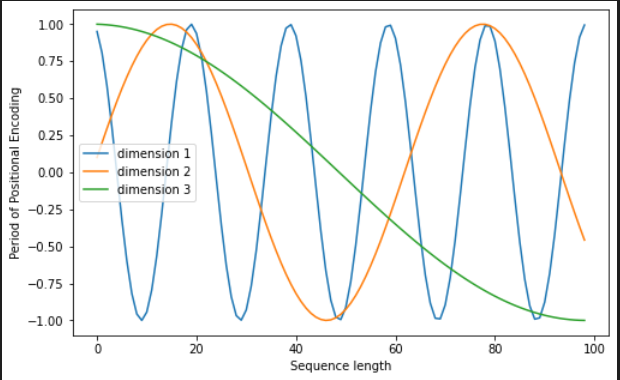
Pad Mask
def get_attn_pad_mask(seq_q, seq_k):
# pad mask的作用:在对value向量加权平均的时候,可以让pad对应的alpha_ij=0,这样注意力就不会考虑到pad向量
"""这里的q,k表示的是两个序列(跟注意力机制的q,k没有关系),例如encoder_inputs (x1,x2,..xm)和encoder_inputs (x1,x2..xm)
encoder和decoder都可能调用这个函数,所以seq_len视情况而定
seq_q: [batch_size, seq_len]
seq_k: [batch_size, seq_len]
seq_len could be src_len or it could be tgt_len
seq_len in seq_q and seq_len in seq_k maybe not equal
"""
batch_size, len_q = seq_q.size() # 这个seq_q只是用来expand维度的
batch_size, len_k = seq_k.size()
# eq(zero) is PAD token
# 例如:seq_k = [[1,2,3,4,0], [1,2,3,5,0]]
# [batch_size, 1, len_k], True is masked
pad_attn_mask = seq_k.data.eq(0).unsqueeze(1)
# [batch_size, len_q, len_k] 构成一个立方体(batch_size个这样的矩阵)
return pad_attn_mask.expand(batch_size, len_q, len_k)
这个函数最核心的一句代码是 seq_k.data.eq(0),这句的作用是返回一个大小和 seq_k 一样的 tensor,只不过里面的值只有 True 和 False。如果 seq_k 某个位置的值等于 0,那么对应位置就是 True,否则即为 False。举个例子,输入为 seq_data = [1, 2, 3, 4, 0],seq_data.data.eq(0) 就会返回 [False, False, False, False, True]
屏蔽子序列的mask
def get_attn_subsequence_mask(seq):
"""建议打印出来看看是什么的输出(一目了然)
seq: [batch_size, tgt_len]
"""
attn_shape = [seq.size(0), seq.size(1), seq.size(1)]
# attn_shape: [batch_size, tgt_len, tgt_len]
subsequence_mask = np.triu(np.ones(attn_shape), k=1) # 生成一个上三角矩阵
subsequence_mask = torch.from_numpy(subsequence_mask).byte()
return subsequence_mask # [batch_size, tgt_len, tgt_len]
get_attn_subsequence_mask 只有 Decoder 会用到,主要作用是屏蔽未来时刻单词的信息。首先通过 np.ones() 生成一个全 1 的方阵,然后通过 np.triu() 生成一个上三角矩阵,下图是 np.triu() 用法

示例代码
import numpy as np
data = [1,2,3,4]
#k=0 表示矩阵定义的一般形式的上三角形
upper_triangle = np.triu(data,0)
print(upper_triangle)
#k=-1表示对角线位置下移动一行
upper_triangle_down = np.triu(data,-1)
print(upper_triangle_down)
#k=1表示对角线位置上移动一行
upper_triangle_up = np.triu(data,1)
print(upper_triangle_up)
'''输出结果
[[1 2 3 4]
[0 2 3 4]
[0 0 3 4]
[0 0 0 4]]
[[1 2 3 4]
[1 2 3 4]
[0 2 3 4]
[0 0 3 4]]
[[0 2 3 4]
[0 0 3 4]
[0 0 0 4]
[0 0 0 0]]
'''
ScaledDotProductAttention
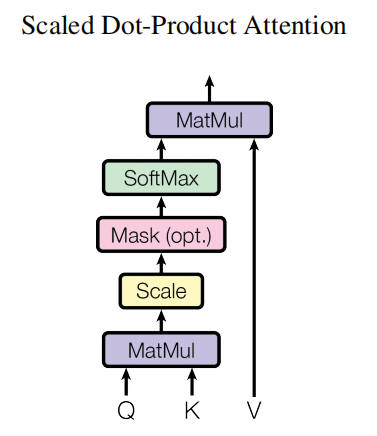
class ScaledDotProductAttention(nn.Module):
def __init__(self):
super(ScaledDotProductAttention, self).__init__()
def forward(self, Q, K, V, attn_mask):
"""
Q: [batch_size, n_heads, len_q, d_k]
K: [batch_size, n_heads, len_k, d_k]
V: [batch_size, n_heads, len_v(=len_k), d_v]
attn_mask: [batch_size, n_heads, seq_len, seq_len]
说明:在encoder-decoder的Attention层中len_q(q1,..qt)和len_k(k1,...km)可能不同
"""
scores = torch.matmul(Q, K.transpose(-1, -2)) / np.sqrt(d_k) # scores : [batch_size, n_heads, len_q, len_k]
# mask矩阵填充scores(用-1e9填充scores中与attn_mask中值为1位置相对应的元素)
scores.masked_fill_(attn_mask, -1e9) # Fills elements of self tensor with value where mask is True.
attn = nn.Softmax(dim=-1)(scores) # 对最后一个维度(v)做softmax
# scores : [batch_size, n_heads, len_q, len_k] * V: [batch_size, n_heads, len_v(=len_k), d_v]
context = torch.matmul(attn, V) # context: [batch_size, n_heads, len_q, d_v]
# context:[[z1,z2,...],[...]]向量, attn注意力稀疏矩阵(用于可视化的)
return context, attn
这里要做的是,通过 Q 和 K 计算出 scores,然后将 scores 和 V 相乘,得到每个单词的 context vector
第一步是将 Q 和 K 的转置相乘没什么好说的,相乘之后得到的 scores 还不能立刻进行 softmax,需要和 attn_mask 相加,把一些需要屏蔽的信息屏蔽掉,attn_mask 是一个仅由 True 和 False 组成的 tensor,并且一定会保证 attn_mask 和 scores 的维度四个值相同(不然无法做对应位置相加)
mask 完了之后,就可以对 scores 进行 softmax 了。然后再与 V 相乘,得到 context
计算过程图解:



这个分数表的含义如下:
- 当模型处理数据集中的第 1 个数据(第 1 行),其中只包含着一个单词 (robot),它将 100% 的注意力集中在这个单词上。
- 当模型处理数据集中的第 2 个数据(第 2 行),其中包含着单词(robot must)。当模型处理单词 must,它将 42% 的注意力集中在 robot,将 57% 的注意力集中在 must。
- 诸如此类,继续处理后面的单词。
Feed Forward和Add&Norm
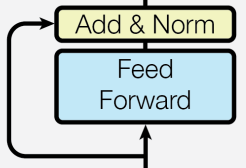
# Pytorch中的Linear只会对最后一维操作,所以正好是我们希望的每个位置用同一个全连接网络
class PoswiseFeedForwardNet(nn.Module):
def __init__(self):
super(PoswiseFeedForwardNet, self).__init__()
self.fc = nn.Sequential(
nn.Linear(d_model, d_ff, bias=False),
nn.ReLU(),
nn.Linear(d_ff, d_model, bias=False)
)
def forward(self, inputs):
"""
inputs: [batch_size, seq_len, d_model]
"""
residual = inputs
output = self.fc(inputs)
return nn.LayerNorm(d_model).to(device)(output + residual) # [batch_size, seq_len, d_model]
MultiHeadAttention


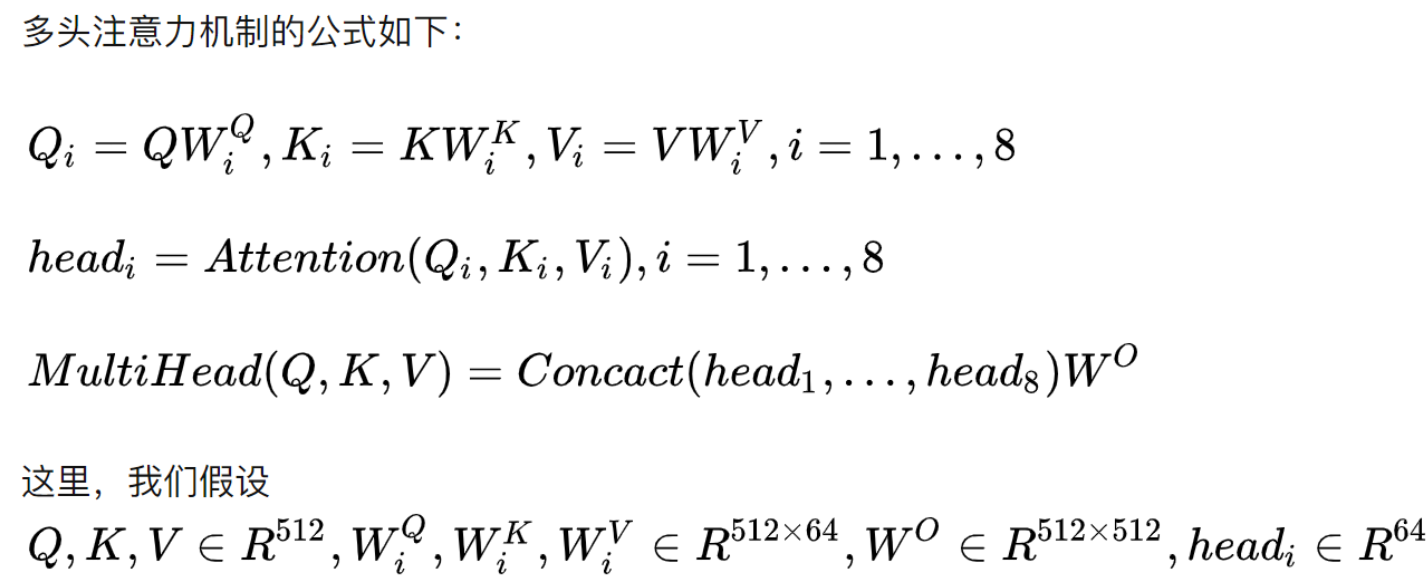
class MultiHeadAttention(nn.Module):
"""这个Attention类可以实现:
Encoder的Self-Attention
Decoder的Masked Self-Attention
Encoder-Decoder的Attention
输入:seq_len x d_model
输出:seq_len x d_model
"""
def __init__(self):
super(MultiHeadAttention, self).__init__()
self.W_Q = nn.Linear(d_model, d_k * n_heads,
bias=False) # q,k必须维度相同,不然无法做点积
self.W_K = nn.Linear(d_model, d_k * n_heads, bias=False)
self.W_V = nn.Linear(d_model, d_v * n_heads, bias=False)
# 这个全连接层可以保证多头attention的输出仍然是seq_len x d_model
self.fc = nn.Linear(n_heads * d_v, d_model, bias=False)
def forward(self, input_Q, input_K, input_V, attn_mask):
"""
input_Q: [batch_size, len_q, d_model]
input_K: [batch_size, len_k, d_model]
input_V: [batch_size, len_v(=len_k), d_model]
attn_mask: [batch_size, seq_len, seq_len]
"""
residual, batch_size = input_Q, input_Q.size(0)
# 下面的多头的参数矩阵是放在一起做线性变换的,然后再拆成多个头,这是工程实现的技巧
# B: batch_size, S:seq_len, D: dim
# (B, S, D) -proj-> (B, S, D_new) -split-> (B, S, Head, W) -trans-> (B, Head, S, W)
# 线性变换 拆成多头
# Q: [batch_size, n_heads, len_q, d_k]
Q = self.W_Q(input_Q).view(batch_size, -1,
n_heads, d_k).transpose(1, 2)
# K: [batch_size, n_heads, len_k, d_k] # K和V的长度一定相同,维度可以不同
K = self.W_K(input_K).view(batch_size, -1,
n_heads, d_k).transpose(1, 2)
# V: [batch_size, n_heads, len_v(=len_k), d_v]
V = self.W_V(input_V).view(batch_size, -1,
n_heads, d_v).transpose(1, 2)
# 因为是多头,所以mask矩阵要扩充成4维的
# attn_mask: [batch_size, seq_len, seq_len] -> [batch_size, n_heads, seq_len, seq_len]
attn_mask = attn_mask.unsqueeze(1).repeat(1, n_heads, 1, 1)
# context: [batch_size, n_heads, len_q, d_v], attn: [batch_size, n_heads, len_q, len_k]
context, attn = ScaledDotProductAttention()(Q, K, V, attn_mask)
# 下面将不同头的输出向量拼接在一起
# context: [batch_size, n_heads, len_q, d_v] -> [batch_size, len_q, n_heads * d_v]
context = context.transpose(1, 2).reshape(
batch_size, -1, n_heads * d_v)
# 这个全连接层可以保证多头attention的输出仍然是seq_len x d_model
output = self.fc(context) # [batch_size, len_q, d_model]
return nn.LayerNorm(d_model).to(device)(output + residual), attn
完整代码中一定会有三处地方调用 MultiHeadAttention(),Encoder Layer 调用一次,传入的 input_Q、input_K、input_V 全部都是 enc_inputs;Decoder Layer 中两次调用,第一次传入的全是 dec_inputs,第二次传入的分别是 dec_outputs,enc_outputs,enc_outputs
Encoder Layer
class EncoderLayer(nn.Module):
def __init__(self):
super(EncoderLayer, self).__init__()
self.enc_self_attn = MultiHeadAttention()
self.pos_ffn = PoswiseFeedForwardNet()
def forward(self, enc_inputs, enc_self_attn_mask):
"""E
enc_inputs: [batch_size, src_len, d_model]
enc_self_attn_mask: [batch_size, src_len, src_len] mask矩阵(pad mask or sequence mask)
"""
# enc_outputs: [batch_size, src_len, d_model], attn: [batch_size, n_heads, src_len, src_len]
# 第一个enc_inputs * W_Q = Q
# 第二个enc_inputs * W_K = K
# 第三个enc_inputs * W_V = V
enc_outputs, attn = self.enc_self_attn(enc_inputs, enc_inputs, enc_inputs,
enc_self_attn_mask) # enc_inputs to same Q,K,V(未线性变换前)
enc_outputs = self.pos_ffn(enc_outputs)
# enc_outputs: [batch_size, src_len, d_model]
return enc_outputs, attn
Encoder
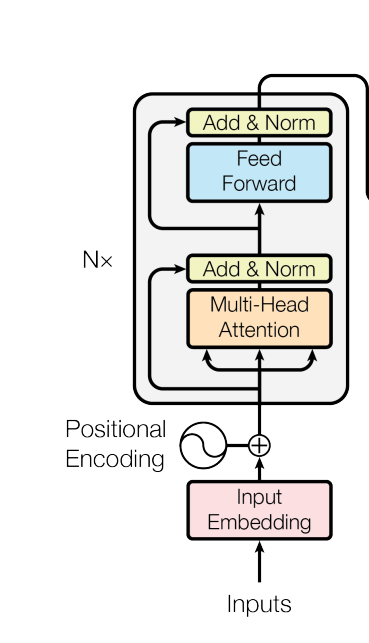
class Encoder(nn.Module):
def __init__(self):
super(Encoder, self).__init__()
self.src_emb = nn.Embedding(src_vocab_size, d_model) # token Embedding
self.pos_emb = PositionalEncoding(
d_model) # Transformer中位置编码时固定的,不需要学习
self.layers = nn.ModuleList([EncoderLayer() for _ in range(n_layers)])
def forward(self, enc_inputs):
"""
enc_inputs: [batch_size, src_len]
"""
enc_outputs = self.src_emb(
enc_inputs) # [batch_size, src_len, d_model]
enc_outputs = self.pos_emb(enc_outputs.transpose(0, 1)).transpose(
0, 1) # [batch_size, src_len, d_model]
# Encoder输入序列的pad mask矩阵
enc_self_attn_mask = get_attn_pad_mask(
enc_inputs, enc_inputs) # [batch_size, src_len, src_len]
enc_self_attns = [] # 在计算中不需要用到,它主要用来保存你接下来返回的attention的值(这个主要是为了你画热力图等,用来看各个词之间的关系
for layer in self.layers: # for循环访问nn.ModuleList对象
# 上一个block的输出enc_outputs作为当前block的输入
# enc_outputs: [batch_size, src_len, d_model], enc_self_attn: [batch_size, n_heads, src_len, src_len]
enc_outputs, enc_self_attn = layer(enc_outputs,
enc_self_attn_mask) # 传入的enc_outputs其实是input,传入mask矩阵是因为你要做self attention
enc_self_attns.append(enc_self_attn) # 这个只是为了可视化
return enc_outputs, enc_self_attns
Decoder Layer
class DecoderLayer(nn.Module):
def __init__(self):
super(DecoderLayer, self).__init__()
self.dec_self_attn = MultiHeadAttention()
self.dec_enc_attn = MultiHeadAttention()
self.pos_ffn = PoswiseFeedForwardNet()
def forward(self, dec_inputs, enc_outputs, dec_self_attn_mask, dec_enc_attn_mask):
"""
dec_inputs: [batch_size, tgt_len, d_model]
enc_outputs: [batch_size, src_len, d_model]
dec_self_attn_mask: [batch_size, tgt_len, tgt_len]
dec_enc_attn_mask: [batch_size, tgt_len, src_len]
"""
# dec_outputs: [batch_size, tgt_len, d_model], dec_self_attn: [batch_size, n_heads, tgt_len, tgt_len]
dec_outputs, dec_self_attn = self.dec_self_attn(dec_inputs, dec_inputs, dec_inputs,
dec_self_attn_mask) # 这里的Q,K,V全是Decoder自己的输入
# dec_outputs: [batch_size, tgt_len, d_model], dec_enc_attn: [batch_size, h_heads, tgt_len, src_len]
dec_outputs, dec_enc_attn = self.dec_enc_attn(dec_outputs, enc_outputs, enc_outputs,
dec_enc_attn_mask) # Attention层的Q(来自decoder) 和 K,V(来自encoder)
# [batch_size, tgt_len, d_model]
dec_outputs = self.pos_ffn(dec_outputs)
# dec_self_attn, dec_enc_attn这两个是为了可视化的
return dec_outputs, dec_self_attn, dec_enc_attn
Decoder
class Decoder(nn.Module):
def __init__(self):
super(Decoder, self).__init__()
self.tgt_emb = nn.Embedding(
tgt_vocab_size, d_model) # Decoder输入的embed词表
self.pos_emb = PositionalEncoding(d_model)
self.layers = nn.ModuleList([DecoderLayer()
for _ in range(n_layers)]) # Decoder的blocks
def forward(self, dec_inputs, enc_inputs, enc_outputs):
"""
dec_inputs: [batch_size, tgt_len]
enc_inputs: [batch_size, src_len]
enc_outputs: [batch_size, src_len, d_model] # 用在Encoder-Decoder Attention层
"""
dec_outputs = self.tgt_emb(
dec_inputs) # [batch_size, tgt_len, d_model]
dec_outputs = self.pos_emb(dec_outputs.transpose(0, 1)).transpose(0, 1).to(
device) # [batch_size, tgt_len, d_model]
# Decoder输入序列的pad mask矩阵(这个例子中decoder是没有加pad的,实际应用中都是有pad填充的)
dec_self_attn_pad_mask = get_attn_pad_mask(dec_inputs, dec_inputs).to(
device) # [batch_size, tgt_len, tgt_len]
# Masked Self_Attention:当前时刻是看不到未来的信息的
dec_self_attn_subsequence_mask = get_attn_subsequence_mask(dec_inputs).to(
device) # [batch_size, tgt_len, tgt_len]
# Decoder中把两种mask矩阵相加(既屏蔽了pad的信息,也屏蔽了未来时刻的信息)
dec_self_attn_mask = torch.gt((dec_self_attn_pad_mask + dec_self_attn_subsequence_mask),
0).to(device) # [batch_size, tgt_len, tgt_len]; torch.gt比较两个矩阵的元素,大于则返回1,否则返回0
# 这个mask主要用于encoder-decoder attention层
# get_attn_pad_mask主要是enc_inputs的pad mask矩阵(因为enc是处理K,V的,求Attention时是用v1,v2,..vm去加权的,要把pad对应的v_i的相关系数设为0,这样注意力就不会关注pad向量)
# dec_inputs只是提供expand的size的
dec_enc_attn_mask = get_attn_pad_mask(
dec_inputs, enc_inputs) # [batc_size, tgt_len, src_len]
dec_self_attns, dec_enc_attns = [], []
for layer in self.layers:
# dec_outputs: [batch_size, tgt_len, d_model], dec_self_attn: [batch_size, n_heads, tgt_len, tgt_len], dec_enc_attn: [batch_size, h_heads, tgt_len, src_len]
# Decoder的Block是上一个Block的输出dec_outputs(变化)和Encoder网络的输出enc_outputs(固定)
dec_outputs, dec_self_attn, dec_enc_attn = layer(dec_outputs, enc_outputs, dec_self_attn_mask,
dec_enc_attn_mask)
dec_self_attns.append(dec_self_attn)
dec_enc_attns.append(dec_enc_attn)
# dec_outputs: [batch_size, tgt_len, d_model]
return dec_outputs, dec_self_attns, dec_enc_attns
Transformer
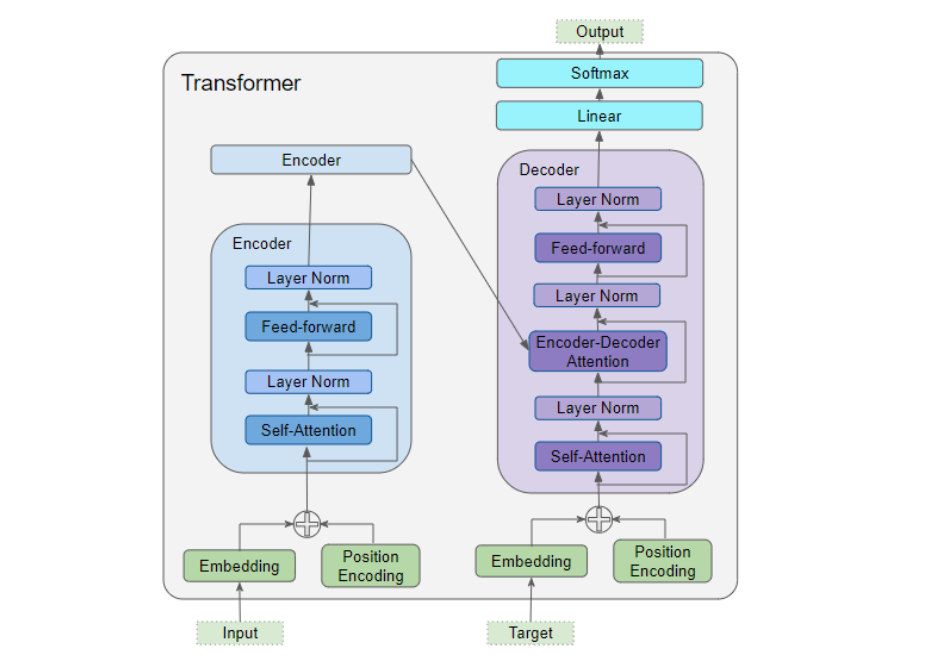
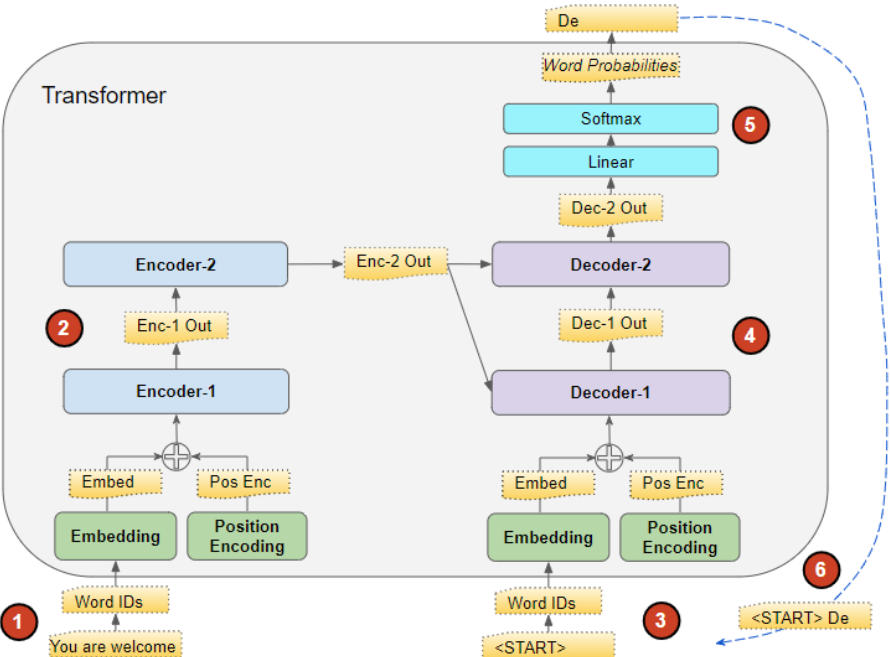
class Transformer(nn.Module):
def __init__(self):
super(Transformer, self).__init__()
self.encoder = Encoder().to(device)
self.decoder = Decoder().to(device)
self.projection = nn.Linear(
d_model, tgt_vocab_size, bias=False).to(device)
def forward(self, enc_inputs, dec_inputs):
"""Transformers的输入:两个序列
enc_inputs: [batch_size, src_len]
dec_inputs: [batch_size, tgt_len]
"""
# tensor to store decoder outputs
# outputs = torch.zeros(batch_size, tgt_len, tgt_vocab_size).to(self.device)
# enc_outputs: [batch_size, src_len, d_model], enc_self_attns: [n_layers, batch_size, n_heads, src_len, src_len]
# 经过Encoder网络后,得到的输出还是[batch_size, src_len, d_model]
enc_outputs, enc_self_attns = self.encoder(enc_inputs)
# dec_outputs: [batch_size, tgt_len, d_model], dec_self_attns: [n_layers, batch_size, n_heads, tgt_len, tgt_len], dec_enc_attn: [n_layers, batch_size, tgt_len, src_len]
dec_outputs, dec_self_attns, dec_enc_attns = self.decoder(
dec_inputs, enc_inputs, enc_outputs)
# dec_outputs: [batch_size, tgt_len, d_model] -> dec_logits: [batch_size, tgt_len, tgt_vocab_size]
dec_logits = self.projection(dec_outputs)
return dec_logits.view(-1, dec_logits.size(-1)), enc_self_attns, dec_self_attns, dec_enc_attns
train
model = Transformer().to(device)
# 这里的损失函数里面设置了一个参数 ignore_index=0,因为 "pad" 这个单词的索引为 0,这样设置以后,就不会计算 "pad" 的损失(因为本来 "pad" 也没有意义,不需要计算)
criterion = nn.CrossEntropyLoss(ignore_index=0)
optimizer = optim.SGD(model.parameters(), lr=1e-3,
momentum=0.99) # 用adam的话效果不好
for epoch in range(epochs):
for enc_inputs, dec_inputs, dec_outputs in loader:
"""
enc_inputs: [batch_size, src_len]
dec_inputs: [batch_size, tgt_len]
dec_outputs: [batch_size, tgt_len]
"""
enc_inputs, dec_inputs, dec_outputs = enc_inputs.to(
device), dec_inputs.to(device), dec_outputs.to(device)
# outputs: [batch_size * tgt_len, tgt_vocab_size]
outputs, enc_self_attns, dec_self_attns, dec_enc_attns = model(
enc_inputs, dec_inputs)
# dec_outputs.view(-1):[batch_size * tgt_len * tgt_vocab_size]
loss = criterion(outputs, dec_outputs.view(-1))
print('Epoch:', '%04d' % (epoch + 1), 'loss =', '{:.6f}'.format(loss))
optimizer.zero_grad()
loss.backward()
optimizer.step()
inference
def greedy_decoder(model, enc_input, start_symbol):
"""贪心编码
For simplicity, a Greedy Decoder is Beam search when K=1. This is necessary for inference as we don't know the
target sequence input. Therefore we try to generate the target input word by word, then feed it into the transformer.
Starting Reference: http://nlp.seas.harvard.edu/2018/04/03/attention.html#greedy-decoding
:param model: Transformer Model
:param enc_input: The encoder input
:param start_symbol: The start symbol. In this example it is 'S' which corresponds to index 4
:return: The target input
"""
enc_outputs, enc_self_attns = model.encoder(enc_input)
# 初始化一个空的tensor: tensor([], size=(1, 0), dtype=torch.int64)
dec_input = torch.zeros(1, 0).type_as(enc_input.data)
terminal = False
next_symbol = start_symbol
while not terminal:
# 预测阶段:dec_input序列会一点点变长(每次添加一个新预测出来的单词)
dec_input = torch.cat([dec_input.to(device), torch.tensor([[next_symbol]], dtype=enc_input.dtype).to(device)],
-1)
dec_outputs, _, _ = model.decoder(dec_input, enc_input, enc_outputs)
projected = model.projection(dec_outputs)
prob = projected.squeeze(0).max(dim=-1, keepdim=False)[1]
# 增量更新(我们希望重复单词预测结果是一样的)
# 我们在预测是会选择性忽略重复的预测的词,只摘取最新预测的单词拼接到输入序列中
# 拿出当前预测的单词(数字)。我们用x'_t对应的输出z_t去预测下一个单词的概率,不用z_1,z_2..z_{t-1}
next_word = prob.data[-1]
next_symbol = next_word
if next_symbol == tgt_vocab["E"]:
terminal = True
# print(next_word)
# greedy_dec_predict = torch.cat(
# [dec_input.to(device), torch.tensor([[next_symbol]], dtype=enc_input.dtype).to(device)],
# -1)
greedy_dec_predict = dec_input[:, 1:]
return greedy_dec_predict
# ==========================================================================================
# 预测阶段
# 测试集
sentences = [
# enc_input dec_input dec_output
['我 有 零 个 女 朋 友 P', '', '']
]
enc_inputs, dec_inputs, dec_outputs = make_data(sentences)
test_loader = Data.DataLoader(
MyDataSet(enc_inputs, dec_inputs, dec_outputs), 2, True)
enc_inputs, _, _ = next(iter(test_loader))
print()
print("="*30)
print("利用训练好的Transformer模型将中文句子'我 有 零 个 女 朋 友' 翻译成英文句子: ")
for i in range(len(enc_inputs)):
greedy_dec_predict = greedy_decoder(model, enc_inputs[i].view(
1, -1).to(device), start_symbol=tgt_vocab["S"])
print(enc_inputs[i], '->', greedy_dec_predict.squeeze())
print([src_idx2word[t.item()] for t in enc_inputs[i]], '->',
[idx2word[n.item()] for n in greedy_dec_predict.squeeze()])
全网最好的Transformers资料都在这里!!!!
如果你不是很了解transformer架构,还是有很多疑惑,请静下心来阅读下面提供的博文,你一定会大有收获。
-
论文链接:https://arxiv.org/pdf/1706.03762.pdf
-
经典网络架构学习-Transformer
-
手把手教你用Pytorch代码实现Transformer模型(超详细的代码解读)
-
Transformer 详解
-
Self-Attention和Transformer
-
Transformers Explained Visually (Part 1): Overview of Functionality
-
Learn-NLP-with-Transformers
-
Transformer模型详解(图解最完整版)
-
The Annotated Transformer
-
TRANSFORMERS FROM SCRATCH
-
Seq2seq pay Attention to Self Attention: Part 2(中文版)
-
torch.nn.Transformer
相关视频
- 李沐transformer论文逐段度
- B站 Transformer的PyTorch实现
- Transformer的PyTorch实现


